As the crescent moon marks the beginning of Ramadan, the streets come alive with a warm glow emanating from the iconic Fanous Ramadan. This lantern holds a special place in the hearts of millions, embodying the spirit of unity, spirituality, and tradition. Beyond its enchanting appearance, this traditional lantern carries a rich history that transcends centuries.
Fanous Ramadan in Egypt:
Fanous originates from Arabic, meaning lamp or lantern. It has a rich history deeply rooted in Egyptian tradition. The story of Fanous Ramadan can be traced back to ancient Egypt. It was used during annual festivals to celebrate the birth of prominent deities in the Pharaonic pantheon. Initially crafted from metal and adorned with colourful glass, these lanterns served as practical light sources and symbolic ornaments.
Its religious significance can be traced back to the 10th century during the Fatimid Caliphate in Egypt. Legend has it that the Caliph Al-Mu’izz li-Din Allah ordered the construction of a dazzling lantern to guide people through the darkened streets of Cairo during the festive nights of Ramadan. It aimed to foster a sense of community and illuminate the path for those partaking in the Tarawih prayers.
Fanous Ramadan Today:
Over time, the Fanous evolved, mirroring the artistic influences of different eras and regions. Its intricate designs began to incorporate geometric patterns, calligraphy, and even verses from the Quran. It turned into a unique form of artistic expression. Despite these changes, the essence of the Fanous remained constant— a guiding light that symbolizes the triumph of good over evil.
In the heart of Cairo’s bustling markets, artisans dedicated to preserving this tradition can still be found. These skilled craftsmen meticulously handcraft each lantern, passing down their techniques from generation to generation. The process involves a delicate dance of hammer and chisel, transforming sheets of metal into a masterpiece that will illuminate homes and streets during Ramadan. Cairo’s historic Khan El Khalili market comes alive during Ramadan, with shops adorned with lanterns of various shapes and sizes. The market becomes a bustling hub of activity as families shop for their own Fanous.
Beyond its aesthetic appeal, Fanous Ramadan holds profound cultural and spiritual significance. Its light is believed to represent the divine guidance that leads believers through the spiritual journey of Ramadan. Families across the Muslim world eagerly anticipate the moment they can unveil their lanterns, creating a sense of joy and anticipation that unites communities during this sacred time.
Fanous Ramadan remains a steadfast symbol of tradition and heritage. Its mesmerizing glow not only brightens the physical space but also serves as a beacon of unity, connecting individuals across borders in the shared experience of faith and devotion. As we embrace the holy month, let Fanous Ramadan continue to illuminate our hearts and homes, transcending time with its timeless glow.

